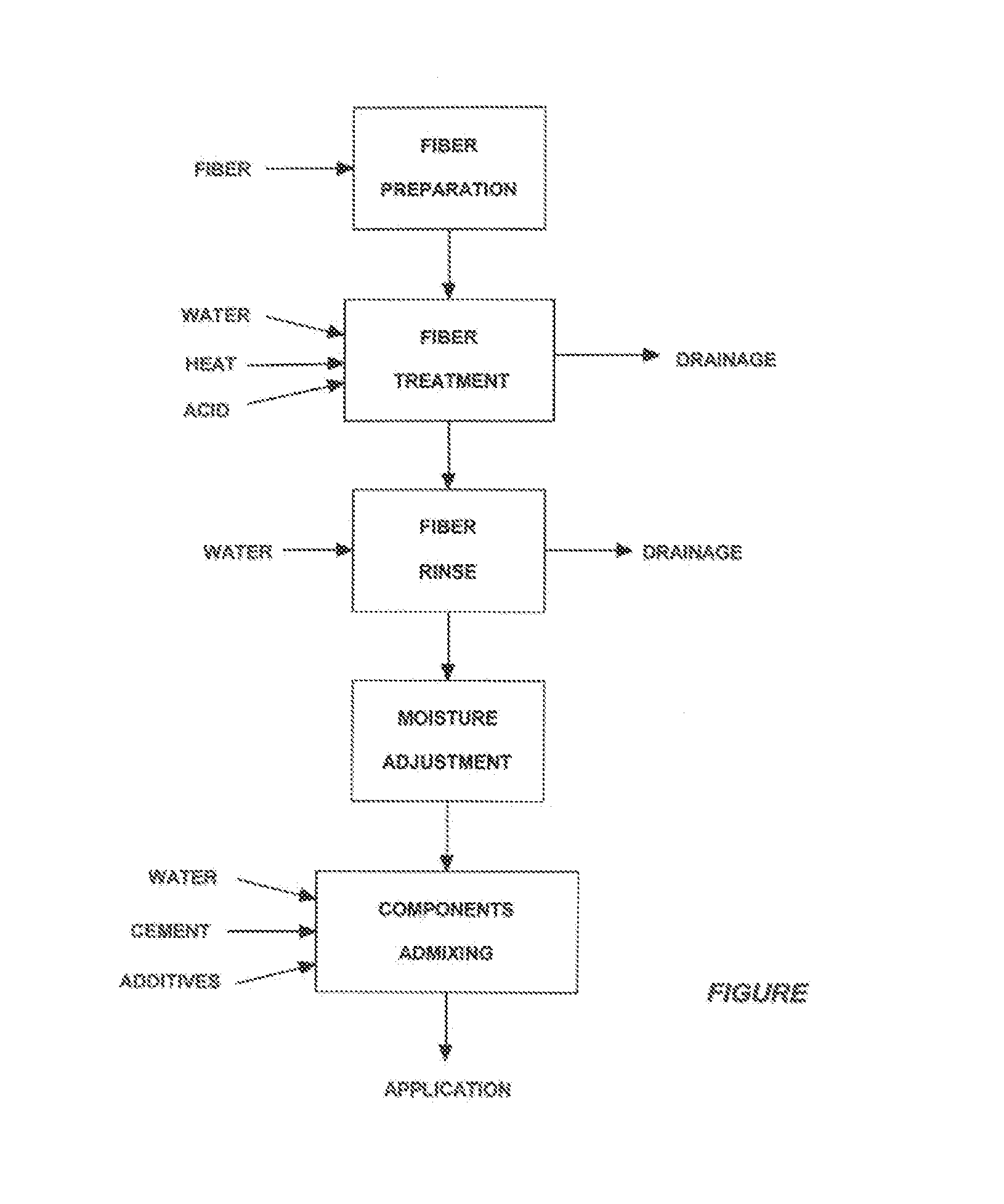Compositions and Methods For Making of a Concrete-Like Material Containing Cellulosic Derivatives
a cellulosic derivative and concrete technology, applied in the field of cementitious materials, can solve the problems of higher water permeability, lower resistance to water-induced damage, and performance drawbacks of cellulose fiber cement materials, and achieve the effect of reducing a cellulosic fiber material
- Summary
- Abstract
- Description
- Claims
- Application Information
AI Technical Summary
Benefits of technology
Problems solved by technology
Method used
Image
Examples
example 1
[0105]Cylinder strength tests were performed on compositions of materials made in accordance with the present invention. The materials were formed into cylinders of 4 inches in diameter and 8 inches in length and tested on a Service Physical Tester, Model PCHD 250 Concrete Tester. The following results were obtained:
First Composition Test SeriesCylinder AgeTotal LoadSample Number(Days)(Pounds)1-1642,5001-2644,5001-3648,5001-4645,0001-52849,000
Second Composition Test SeriesSampleCylinder AgeTotal LoadNumber(Days)(Pounds)2-1746,0002-2739,5002-3871,5002-4930,0002-5947,5002-6923,0002-7953,500
Third Composition Test SeriesSampleCylinder AgeTotal LoadNumber(Days)(Pounds)3-1A745,5003-1B752,0003-11464,0003-12860,5003-2A752,0003-2B755,0003-21458,0003-22862,000
[0106]It is to be noted that Sample 2-2 was made with a weight proportion of about 7.5 pounds cement to 3.2 pounds of wet fiber and 78 ounces of water added to make the sample. It is further noted that Sample 2-3 was made with a proporti...
example 2
[0107]Two samples of the inventive composition, A and B respectively, were made using the following formulation for each cubic yard of sample:
10 bags cement940 poundsWater480 poundsInventive treated fiber240 pounds
[0108]Sample A was mixed in a typical truck barrel mixer as used in conventional “ready mix” operations. Sample B was mixed in a high speed vertical mixer at a rotation speed of about 3,000 to 6,000 revolutions per minute for a similar length of time.
[0109]A standard compression test after 30 days as for a concrete test cylinder produced the following results:
SampleCompression Strength (psi)A5,000 to 7,000 B7,000 to 12,000
[0110]Rice husk ash has been shown to perform well as a supplementary cementitious material. However, the use of unburned, rice husks in concrete is a novel idea. Rice husks are one of the world's most abundant renewable waste resources. Approximately 130 million tons of rice husks are produced annually. Thus, using rice husks as a component of concrete i...
example 3
[0116]Because the rice husks represented a gap-graded situation when used as the sole aggregate, several mixes were prepared using additional aggregate made up of a fine (approx. 2.2 FM) sand. In total, seven mixes were prepared. The final mix (#7) was prepared in response to the unusually high absorption numbers of the previous six mixes in an attempt to show that the absorption rate could be controlled easily.
[0117]The materials used for this project included:
[0118]Cement: ASTM C150 Type I / II Buzzi Unicem, Chattanooga, Tenn.
[0119]Rice Husks: As supplied
[0120]Sand: ASTM C33 Natural Sand, Sand Switch, Dunlap, Tenn.
[0121]Water: City, Potable
[0122]Admixture: Polyheed 900, BASF Admixtures
[0123]Integral Waterproofing: Treat-Proof, Spraylock Concrete Protection, Chattanooga, Tenn.
RiceMixCementHusksSandWater#(lbs.)(lbs.)(lbs.)(lbs.)Other19003600918.3212001601000918.331200390262.241200201000262.25120080500416.5+12 oz. / cwt Polyheed 900612001030416.5+12 oz. / cwt Polyheed 900712002060416.5+12 ...
PUM
| Property | Measurement | Unit |
|---|---|---|
| Length | aaaaa | aaaaa |
| Length | aaaaa | aaaaa |
| Length | aaaaa | aaaaa |
Abstract
Description
Claims
Application Information
 Login to View More
Login to View More - R&D
- Intellectual Property
- Life Sciences
- Materials
- Tech Scout
- Unparalleled Data Quality
- Higher Quality Content
- 60% Fewer Hallucinations
Browse by: Latest US Patents, China's latest patents, Technical Efficacy Thesaurus, Application Domain, Technology Topic, Popular Technical Reports.
© 2025 PatSnap. All rights reserved.Legal|Privacy policy|Modern Slavery Act Transparency Statement|Sitemap|About US| Contact US: help@patsnap.com


